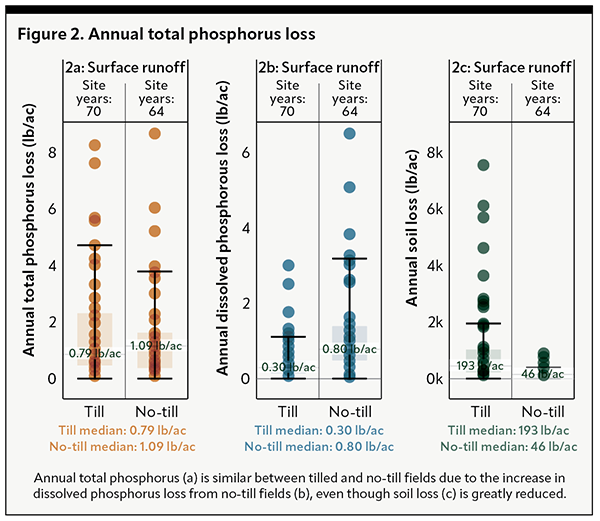The author is an ag and water quality outreach specialist with University of Wisconsin-Madison Extension.

Historically, reduced tillage — defined as tillage that maintains plant surface residue and where nutrients are surface applied — was touted as the solution for phosphorus loss from agricultural fields. Examples include no-till, zone-till, strip-till, or vertical tillage.
This article elevates the issue of phosphorus loss without erosion by highlighting dissolved phosphorus loss pathways. Reduced tillage cuts back phosphorus loss risk through two main processes: by decreasing soil erosion and increasing soil’s infiltration capacity.
Realize the benefits
Preventing topsoil from leaving the field provides many agronomic and water quality benefits by keeping valuable soil-bound phosphorus nutrients in the field and soil out of surface waters. Reduced tillage leaves a protective residue on the surface, physically protecting the soil by intercepting powerful raindrops from hitting the surface and dislodging soil, which is then more susceptible to erosion.
Wisconsin’s Discovery Farms edge-of-field monitoring shows that around 50% of the total phosphorus that leaves fields in Wisconsin is typically in this particulate form. It is commonly lost in late spring and early summer when heavy precipitation is paired with no canopy cover and unfrozen ground (Figure 1).

A second, less discussed, benefit is the ability of reduced tillage to raise soil’s water infiltration capacity. The reduction in disturbance allows for greater organic matter protection, worm activity, and microbial activity, which helps improve soil aggregate stability and create channels where water can infiltrate.
When the ground is unfrozen, fields that infiltrate more water effectively reduce the amount of water running off the field into surface water bodies. Less surface water leaving the field typically means less particulate and dissolved phosphorus loss. Smaller volumes of water carry less soil and interact with fewer sources of water-soluble phosphorus.
Just under the surface
Reduced tillage can have trade-offs. The previously mentioned benefits mostly reduce phosphorus loss on unfrozen ground, which is typically when 50% of the phosphorus loss occurs in Wisconsin.
Recent research and monitoring have shown that reduced tillage can intensify dissolved phosphorus loss by increasing the amount of phosphorus at the soil surface. Dissolved phosphorus loss is not dependent on soil movement. Rather, it is driven by water interacting with organic and water-soluble forms of phosphorus, like residue, synthetic fertilizer, manure, or even phosphorus attached to soil. Dissolved phosphorus is often lost in winter months when the soil is frozen, snowmelt is occurring, and little infiltration into the soil can occur (Figure 1).
In reduced tillage systems, there tends to be a build up of residue or plant biomass on the soil surface, which are all sources of phosphorus. Long-term reduced tillage fields can lead to higher phosphorus levels in the top inch or two of the soil due to broadcast applications of manure and synthetic fertilizer. This stratification of phosphorus at the soil surface creates a high risk for interaction between phosphorus sources and a large amount of runoff water via snowmelt, rain, or both.
These processes occur in Wisconsin and throughout the Upper Midwest. Twenty years of Discovery Farms monitoring has shown that annual total phosphorus loss between conventionally tilled and no-till fields is about equal. Soil loss is greatly reduced (Figure 2a and 2c) under no-till but, as discussed above, it can result in increased phosphorus losses in the dissolved form (Figure 2b).

In the Lake Erie watershed, where cover crops, reduced tillage, and other conservation practices have been heavily adopted, dissolved phosphorus loads have doubled in the 2000s compared to the 1990s. This occurred even though the total phosphorus loads have stayed relatively the same.
Make some adjustments
The benefits of reduced tillage to other soil and agronomic properties should not be overlooked. Small adjustments can be made to maintain the positives of reduced tillage while minimizing sources of phosphorus on the surface.
Here are some recommended strategies that can be used to mitigate dissolved phosphorus losses:
1. Reduce phosphorus applications and use crop removal to draw down soil test phosphorus (STP) over time.
Soil’s ability to bind phosphorus to its surface has led to it being a major source of phosphorus rather than a sink after years of application of phosphorus greater than crop removal. High STP values have doubled over the last 50 years. STP in the top inch of the soil is related to the amount of dissolved phosphorus loss in agricultural fields (Figure 3). A typical corn crop in Wisconsin only removes 3 to 5 parts per million (ppm) of phosphorus per year if no other phosphorus is applied. As a result, drawdown of STP can take awhile.

2. Place fertilizer and manure under the surface.
Banding or injecting fertilizer or manure below the top inch of the soil can help with soil stratification and dissolved phosphorus loss. Occasional deep tillage may help relieve soil fertility stratification, but it comes with a trade-off of soil loss if no other erosion control methods are used.
3. Optimize the timing of phosphorus application in fields.
Avoid fertilizer or manure application when the ground is frozen (January to March), especially on snow, as it has little chance to interact with the soil before a runoff event occurs. Instead, the phosphorus has ample time to interact and dissolve into runoff water (Figure 4).

4. Choose to plant cover crop species that overwinter.
Winter-killed cover crops like brassicas and oats act to raise the amount of phosphorus at the surface. The cover crops take up phosphorus from different layers of the soil, but their cells rupture after frost and release phosphorus as the residue breaks down during periods of higher runoff risk. Frost hardy or overwintering cover crops have adapted to protect their cells with antifreeze proteins, reducing the amount of water extractable phosphorus.
It’s not one size fits all
Many farms have made significant strides in adoption of reduced tillage practices that work to lessen agriculture’s impact on water quality through erosion control. However, a blanket approach will not solve complex water quality issues. Reducing excess phosphorus at the soil surface through deeper fertility placement and STP drawdown is the next goal agriculture can work toward to reduce dissolved phosphorus losses associated with the reduced tillage systems.
This article appeared in the February 2023 issue of Journal of Nutrient Management on pages 10-12. Not a subscriber? Click to get the print magazine.





